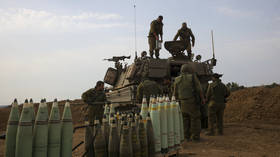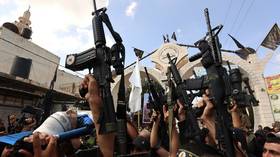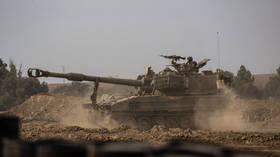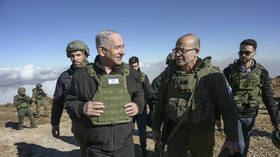Mikhail Khodarenok: Israel’s war on Hamas could lead to the end of the Gaza exclave

On Saturday, Hamas militants attacked Israel, quickly seizing several border settlements and establishing control over a large area of territory.
The terrorists used bulldozers to overcome fences on the frontier with Gaza. The use of boats (in small amphibious landings) and paragliders was notable in the course of the fighting.
Taking advantage of the total surprise of the attack, the terrorists managed to take partial control of the relatively large Israeli towns of Sderot, Netivot, Ashkelon, and Ofakim, as well as some settlements and kibbutzim in border areas.
Hamas militants also stormed Israel Defense Forces (IDF) bases at Kibbutz Re’im and Nahal Oz. The IDF suffered significant losses in terms of killed, wounded, and captured. The total size of the invading force has been estimated at around 1,000 (essentially a reinforced battalion).
Was there an intelligence failure?
Many observers have been quick to attribute Hamas’ successes to miscalculations by the Israeli security services and the IDF. There is no doubt that there were some shortcomings.
In general, however, the accusation that the Israeli security services were caught napping by the attack is clearly exaggerated. In fact, virtually all of Hamas’ preliminary actions on the eve of October 7 were not related to the preparation of an armed invasion as such.
After all, even the most sophisticated Israeli technical intelligence could not, by definition, reveal the formation of strike groups, their occupation of areas of operation, the deployment of rearguards, and many other things that precede a classic armed invasion. Moreover, Hamas did not create any such strike groups.
Yes, there was some movement along Gaza’s borders with Israel, as there always has been. Kassam-type rockets were still being hammered out by the hundreds and thousands in craft workshops, but that too is a common activity in the Gaza Strip. There were, as always, violent demonstrations waving automatic rifles, machine guns, and rocket-propelled grenades, but it is still very difficult to associate the movement of two or three bulldozers towards the border with preparations for the outbreak of a military conflict.
It should also be noted that Hamas did not need a large fresh supply of weapons and military equipment, which could have been detected by the relevant intelligence services, to carry out Saturday’s attack. It had sufficient resources of its own for a military action of this magnitude – adventurous and suicidal in nature and without any ultimately positive consequences for the group.
It should be added that, for objective reasons, it is very, very difficult to work as an agent among the population of the Gaza Strip. In addition, only a very narrow circle of people, mostly related by family ties, are allowed to make fundamental decisions within Hamas.
Therefore, the accusations against the Israeli intelligence services certainly have their place, but at the same time all the abovementioned circumstances must be taken into account.
Has the Israeli war machine failed?
There are also doubts among some experts about the effectiveness of Israel’s Iron Dome anti-missile system. However, the point here is that every anti-aircraft and defense system is limited by what is known as rate-of-fire. That is, the ability to defeat an airborne enemy attack at a certain density: to engage, track, and shoot down a certain number of targets (for example, 25 per minute).
If the enemy launches 5,000 Kassam missiles in 20 minutes, no dome can cope with that number of targets. If each target were to be fired at in a two-missile burst (as is common in combat operations), at least 10,000 defense missiles would be required, at a cost of $20,000 each (and that’s in 2014 prices). There are indications that Israel has already requested additional systems from the US.
It has also been reported that Hamas formations seized several Merkava tanks (including the latest modification, the IV variant) from the IDF, some of which have been burned. However, it is unlikely that the terrorists will be able to use this armor in combat as it requires a completely different level of training. According to some reports, Hamas could not even start a Merkava IV, let alone use its fire control system.
Thus, the claim that Hamas’ armed units base their actions on analysis of their own experience and the enemy’s weaknesses, as well as a detailed study of the latest trends in modern military art in armed conflict zones, is an exaggeration by some analysts. The militants do not demonstrate anything “cutting-edge” in the field of military art.
What to expect from the fighting on the ground?
As for the possible entry of Hezbollah (a Shia group in Lebanon and essentially an Iranian proxy) into the fighting on the side of Hamas, this could certainly complicate the overall situation for Israel. But at the same time, Hezbollah’s fighting capabilities should not be exaggerated. In the course of the armed conflict in Syria, it has not proven to be a formidable military force, something of which Russian military experts are well aware.
A more important and complex problem for the Israeli army is that in densely populated Gaza, it is virtually impossible to separate Hamas targets from civilians, especially as terrorists use the population as human shields.
Israel’s leaders need to be as categorical as possible about the strategic objectives of this conflict. There is little doubt that their high-tech, modern forces are capable of defeating Hamas formations head-on. The IDF has already retaken control of all the territories and population centers previously captured by the terrorists.
It is unlikely, however, that the conflict will end with the Israeli military left at the borders. In any case, there has to be the temptation to inflict such losses on Hamas formations that the movement forgets about any armed struggle for many years.
Therefore, the IDF’s most advanced weapons, including powerful bunker-busting bombs, will soon be used. In addition, Israel must recover its prisoners of war and hostages. This means that a general military operation in Gaza (politologists usually call it a ground operation) will begin any day now.
Thus, it cannot be ruled out that the entire territory of the Palestinian exclave will soon be under the control of the Israelis.
















